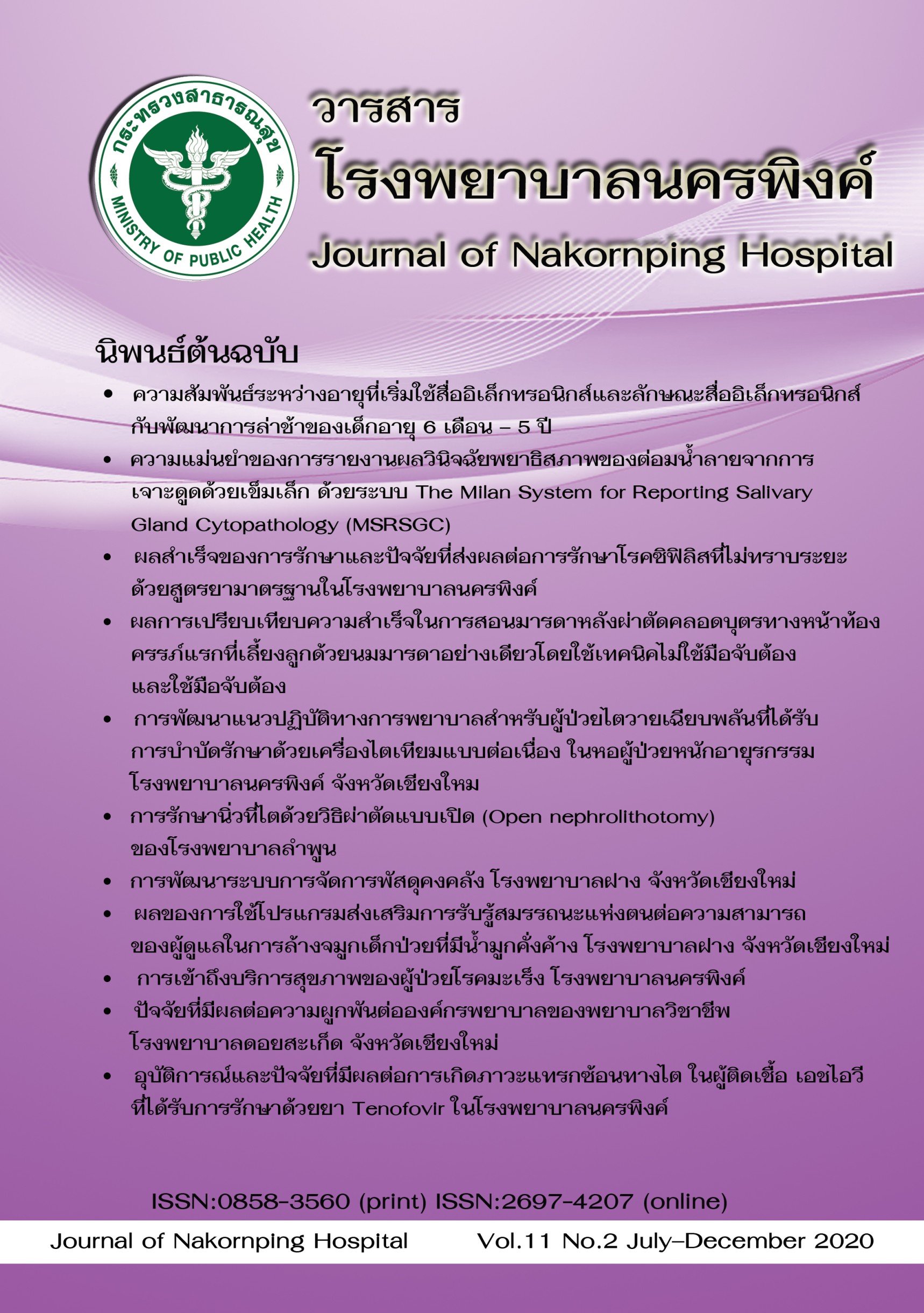Relationship between the Age Onset and Characteristics of Electronic Media Using and Developmental Delay in Children Age 6 Months – 5 Years Old
Keywords:
Child development, developmental delay, electronic media, screen media use, early childhoodAbstract
Background: Presently, the numbers of Thai early childhood with normal development tend to decrease. Contrary to the screen media exposure that tends to increase with the age of children. Thus, the researcher has aimed to study the relationship between the screen media exposure and the developmental delay in early childhood aged 6 months – 5 years including the onset and types of screen media exposure.
Method of study: Cross-sectional, case-control analog study was conducted. One hundred and seventy-four children aged 6 months - 5 years who visited at the well child clinic and pediatric outpatient clinic at Nakornping hospital in March 2020 were enrolled into this study. The screen media exposure questionnaire was used and developmental assessment was done by using the Developmental Surveillance and Promotion Manual (DSPM).
Results: Forty-nine out of 174 children (28.2%) had developmental delay while 85 children (48.9%) had screen media exposure before 2 years of age. Baseline characteristics were similar in both delayed and normal development. Children who had screen media exposure before 2 years of age had developmental delay compared to children who exposed later, Adj.OR 3.75, 95%CI = 1.47 - 9.59, p = 0.008. The type of screen media exposure; smartphone and music players or DVDs, associated with a significant developmental delay, Adj.OR 15.79, 95%CI = 1.02 - 243.74, p = 0.048 and 30.90, 95%CI = 1.81-528.31, p = 0.018 than children who did not expose respectively.
Conclusion: The onset and type of screen media exposure had influenced in developmental delay in early childhood. Screen media exposure before 2 years of age had related to developmental delay.
References
Kabali HK, Irigoyen MM, Nunez-Davis R, Budacki JG, Mohanty SH, Leister KP, et al. Exposure and Use of Mobile Media Devices by Young Children. Pediatrics. 2015;136(6):1044-1150.
Lin LY, Cherng RJ, Chen YJ, Chen YJ, Yang HM. Effects of television exposure on developmental skills among young children. Infant Behav Dev. 2015;38:20-26.
อภิรพี เศรษฐรักษ์ ตันเจริญวงศ์, ศรีรัฐ ภักดีรณชิต, ญาณวุฒิ เศวตธิติกุล. พฤติกรรมการใช้หน้าจอของเด็กไทยวัย 0 – 3 ปี ในเขตกรุงเทพมหานคร. วารสารวิชาการนวัตกรรมสื่อสารสังคม. 2561;6(2):60-69.
Rideout V. The Common Sense census: Media use by kids age zero to eight. San Francisco, CA: Common Sense Media. 2017:263-283.
สำนักส่งเสริมสุขภาพ. รายงานการสำรวจพัฒนาการเด็กปฐมวัยประจำปี 2553. นนทบุรี: สำนักส่งเสริมสุขภาพ กรมอนามัย; 2554.
จินตนา พัฒนพงศ์ธร, ชัยชนะ บุญสุวรรณ, นฤมล ธนเจริญวัชร. รายงานการศึกษา พัฒนาการเด็กปฐมวัยไทย ปี พ.ศ. 2557. นนทบุรี: สำนักส่งเสริมสุขภาพ กรมอนามัย; 2558.
จินตนา พัฒนพงศ์ธร, วันนิสาห์ แก้วแข็งขัน. รายงานการศึกษาปัจจัยที่มีผลต่อพัฒนาการเด็กปฐมวัยไทยครั้งที่ 6 พ.ศ.2560. กรุงเทพฯ: ซีจีทูล; 2561.
กิติมา พัวพัฒนกุล, สุรีพร เกียรติวงศ์ครู, ภัทราพร ศรีสูงเนิน, พรชเนตต์ บุญคง. สรุปผลการดำเนินงาน โครงการส่งเสริมพัฒนาการเฉลิมพระเกียรติสมเด็จพระเทพรัตนราชสุดาฯ สยามบรมราชกุมารี ในโอกาสฉลองพระชนมายุ 5 รอบ 2 เมษายน 2558. กรุงเทพฯ: สถาบันพัฒนาอนามัยเด็กแห่งชาติ กรมอนามัย กระทรวงสาธารณสุข; 2561.
Council on Communications and Media. Media and young minds. Pediatrics. 2016;138(5):e20162591.
Christakis DA. Interactive media use at younger than the age of 2 years: time to rethink the American Academy of Pediatrics guideline?. JAMA Pediatr. 2014;168(5):399-400.
World Health Organization. Guidelines on physical activity, sedentary behaviour and sleep for children under 5 years of age. Geneva: World Health Organization; 2019.
Supanitayanon S, Trairatvorakul P, Chonchaiya W. Screen media exposure in the first 2 years of life and preschool cognitive development: a longitudinal study. Pediatr Res. 2020;88(6):894-902.
ตวงพร ชุมประเสริฐ, วันธณี วิรุฬห์พานิช, พิสมัย วัฒนสิทธิ์. ความสัมพันธ์ระหว่างการใช้สื่ออิเล็กทรอนิกส์กับพัฒนาการเด็กอายุ 2-5 ปี ในศูนย์พัฒนาเด็กเล็ก สังกัดองค์กรปกครองส่วนท้องถิ่น จังหวัดสงขลา. วารสารเครือข่ายวิทยาลัยพยาบาลและการสาธารณสุขภาคใต้. 2562;6(2):91-104.
Anderson DR, Pempek TA. Television and Very Young Children. Am Behav Sci. 2005;48(5):505-522.
Chonchaiya W, Pruksananonda C. Television viewing associates with delayed language development. Acta Paediatr. 2008;97(7):977-982.
Zimmerman FJ, Christakis DA, Meltzoff AN. Associations between media viewing and language development in children under age 2 years. J Pediatr. 2007;151(4):364-368.
Zimmerman FJ, Christakis DA. Associations between content types of early media exposure and subsequent attentional problems. Pediatrics. 2007;120(5):986-92.
Christakis DA, Garrison MM, Herrenkohl T, Haggerty K, Rivara FP, Zhou C, et al. Modifying Media Content for Preschool Children: A Randomized Controlled Trial. Pediatrics. 2013;131(3):431-8.
Mendelsohn AL, Brockmeyer CA, Dreyer BP, Fierman AH, Berkule-Silberman SB, Tomopoulos S. Do Verbal Interactions with Infants During Electronic Media Exposure Mitigate Adverse Impacts on their Language Development as Toddlers?. Infant Child Dev. 2010;19(6):577-593.
Mendelsohn AL, Dreyer BP, Brockmeyer CA, Berkule-Silberman SB, Huberman HS, Tomopoulos S. Randomized controlled trial of primary care pediatric parenting programs: effect on reduced media exposure in infants, mediated through enhanced parent-child interaction. Arch Pediatr Adolesc Med. 2011;165(1):42-48.
ถนอมรัตน์ ประสิทธิเมตต์. พัฒนาการเด็กปฐมวัยไทย เขตบริการสุขภาพที่ 4. วารสารสมาคมเวชศาสตร์ป้องกันแห่งประเทศไทย. 2558;5(2):173-187.
ชัชฎา ประจุดทะเก. ปัจจัยที่มีความสัมพันธ์ต่อพัฒนาการเด็กปฐมวัย ในเขตสุขภาพที่ 9 ปี 2560. วารสารศูนย์อนามัยที่ 9. 2561;12(28):5-19.
กระทรวงสาธารณสุข. คู่มือเฝ้าระวังและส่งเสริมพัฒนาการเด็กปฐมวัย. นนทบุรี: องค์การสงเคราะห์ทหารผ่านศึก; 2563.
Radesky JS, Schumacher J, Zuckerman B. Mobile and interactive media use by young children: the good, the bad, and the unknown. Pediatrics. 2015;135(1):1-3.
Wartella E, Robb M. YOUNG CHILDREN, NEW MEDIA. J Child Media. 2007;1(1):35-44.
Tomopoulos S, Dreyer BP, Berkule S, Fierman AH, Brockmeyer C, Mendelsohn AL. Infant media exposure and toddler development. Arch Pediatr Adolesc Med. 2010;164(12):1105-1111.
Tanimura M, Okuma K, Kyoshima K. Television Viewing, Reduced Parental Utterance, and Delayed Speech Development in Infants and Young Children. Arch Pediatr Adolesc Med. 2007;161(6):618-619.
สมัย ศิริทองถาวร. การพัฒนาคู่มือเฝ้าระวังและส่งเสริมพัฒนาการเด็กปฐมวัย. วารสารสมาคมจิตแพทย์แห่งประเทศไทย. 2561;63(1):3-12.
Downloads
Published
How to Cite
Issue
Section
License
The articles that had been published in the journal is copyright of Journal of Nakornping hospital, Chiang Mai.
Contents and comments in the articles in Journal of Nakornping hospital are at owner’s responsibilities that editor team may not totally agree with.



